OMM REHABILITATION OF THE EXTREMITIES – Flashcards
Unlock all answers in this set
Unlock answersquestion
What are the goals of Rehab and how are they acheived?
answer
Goals to restore function, ADLs, mobility, quality of life Achieved through modalities, manual therapies (OMT!), bracing, exercises, patient education
question
What are the phases of Rehab?
answer
Proper phases in order for best outcome: 1 decrease pain/swelling, 2 restore ROM and normal arthrokinematics, 3 strength training, 4 neuromuscular control and proprioceptive training, 5 functional or sport specific training
question
What are the Therapeutic Modalities
answer
Heat - Superficial heat: hydrocollator packs, heating pads, fluidotherapy, paraffin baths - Deep heat: Ultrasound, hydrotherapy, whirlpool, contrast baths Cold - Cold packs, ice massage, cold water immersion, vapocoolant spray Electrotherapy - Neuromuscular electrical stimulation, transcutaneous electrical stim (TENS), interferential current therapy, iontophoresis
question
What are the different Manual Therapies
answer
*Manual therapy: soft tissue and ME at this stage will give up most "bang for buck" * Joint mobilization - Gentle ROM, stretch, HVLA (PT not allowed to do - Grade 5 mobilization ie HVLA) Muscle Energy Counterstrain MFR Soft tissue Active release technique (ART) Massage Traction
question
Therapeutic Exercise and Patient Education
answer
ROM Strengthening Proprioception Functional activities Home Exercise Program
question
Physical Therapy: How do we direct care?
answer
Dx: Low back pain Rx: Evaluate and treat
question
Describe Prescription Writing
answer
Need pt name/date, write PT (gross movement, usually lower extremity) vs OT (more task orientated, usually upper extremity) - Write Dx, therapist needs to know - What precautions that should be taken - Frequency of visits/tx duration - Tx type: modalities, manual therapy, exercise, special equipment or bracing, etc - Pt education, home exercise plan - Goals of pt: helps everyone know what pt is hoping to gain/how hard to push
question
Have a Dx: Lumbar spondylosis L4-5 & L5-S1 with facet mediated pain how do you tx with Physical therapy
answer
Physical Therapy 2-3x/week for 8 weeks Modalities, manual therapy Core strength, pelvic girdle stability HEP
question
What is essential to maintain the new changes form Physical therapy
answer
*Exercise is KEY* - Successful therapeutic interventions will not be able to sustain themselves over prolonged time - Compensation and chronic injury patterns will induce a reversal to the "original" pathological condition - Exercise, including muscular and fascial retraining is essential to maintain the new changes
question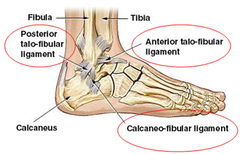
What is an Ankle Sprain and what are the ligaments involved

answer
Excessive inversion on plantar flexed ankle (Supination/inversion most unstable position of ankle. Dorsiflexion/eversion most stable position) Ligaments involved - *Anterior talofibular (ATF)-MOST COMMON* - Calcaneofibular (CF) - Posterior talofibular (PTF)
question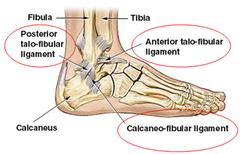
What are the types of Ankle sprains

answer
Grade 1 (mild) Stretch/minor ATF tear Grade 2 (moderate) Partial/complete tear Of ATF, stretch CF Grade 3 (severe) Complete rupture ATF & CF, partial PTF tear
question
Describe Ankle Sprain Physical Examination
answer
1) Inspection, palpation, neurovascular exam 2) Ligament testing - Anterior drawer: ATFL --> Positive if >5mm anterior displacement - Talar tilt: CFL, apply inversion stress to ankle --> Positive if >10° side to side difference 2) Adjacent joints above/below (knee and foot) 3) X-ray used to r/o fracture - Ottawa ankle rules to determine when XR warranted - Pain at malleolar regions, inability to bear weight, midfoot pain, tenderness at navicular or head of 5th metatarsal
question
17 yo male c/o anterolateral ankle pain after rolling it playing b-ball 3 days ago, no prior history of sprains Wants to play college b-ball PE: Antalgic gain, mild left lateral ankle swelling, no ecchymosis, tenderness at distal lateral malleoli, + anterior drawer test with mild laxity, neurovascular intact, ankle dorsiflexion mildly reduced Describe the approach to rehabilitation
answer
1) PRICE (pain reduction/restore ROM) - Lace-up brace, aircast, cane/crutches (to offload and protect joint) - Ice, compressive garments, elevation (to decrease swelling) - AROM/PROM: ankle alphabets/circles, gastroc/soleus stretches 2) Therapeutic Modalities - Ice, Ice , MORE ICE; 20 min max q1h - NSAIDS...controversial for ligament healing 3) Therapeutic exercises (ROM, Strength, Proprioception, Function/Sport Specific Techniques) - ROM-Strengthening - Using resistance bands, dorsiflexors and everters most important muscle group to strengthen (Controls excessive inversion/plantarflexion leading to recurrent sprain) 4) Once ROM/Strength improved - Proprioception, function and sport specific techniques --> Single leg stance activities on various surfaces with eyes open/closed 5) Specialized Treatments for Ankle reabilitation 6) Supportive bracing Tape and/or lace up brace 7) HEP - Starts DAY 1! - Good education critical for compliance - PRICE, ROM, balance and single leg activities (ie washing dishes, brushing teeth) progress to uneven surfaces/eyes closed
question
What are Specialized Treatments for Ankle reabilitation
answer
- Gait/kinetic chain eval: proximal muscle dysfunction found after unilateral ankle sprain - Core muscle strength and activation: Glut medius/maximus, transversus abdominus, multiplanar/multidirections
question
What is the PT Prescription for an Ankle Sprain
answer
PT 2-3x/wk for 8-12 wks Dx: Lateral ankle sprain, Grade 1 Precautions: WBAT/Goals: Return to bball Treatment: - Modalities prn - Therapeutic exercise: A/PROM, stretching to restore DF, balance/proprioceptive training, neuromuscular reeducation, aerobic exercises - Please provide HEP
question
Take Home Points for Ankle Rehab
answer
Follow logical progression Literature supports early/accelerated rehab program for Grade 1-2 sprains Tape or lace up braces recommended after 1st sprain to prevent recurrent sprains Neuromuscular retraining and proprioceptive exercises KEY to successful rehab and future prevention Kinetic chain only as good as weakest link Need to rehab deficits UPSTREAM AND DOWNSTREAM from the hip
question
HPI: 54 yo L handed male with insidious onset R shoulder pain, 6/10 without radiation. Denies neck pain, paresthesias, weakness NSAIDs improve pain, overhead activity worsens PMHx: HTN. PSHx: None. FHx: NC. SHx: smokes 1ppd, drinks 1 case beer/wknd, house painter, motorcycle rider Meds: 800 g ibuprofen tid without food PE: Inspection no gross deformities, no erythema; decreased ROM in all planes (flexion & adduction), tenderness to palpation over AC joint, +Cross arm test with audible cavitation "clunk" heard when pt reached across his body or over head, +Neer, +Hawkings; -Spurling's, inf border scapula protracted, delayed scap abd/ ext rot with abduction OMM Exam: T2-5 NRRSL Increased AP translation of R clavicle R clavicle superiorly displaced compared to L clavicle Restricted pec-clavicular fascia Tender points: R pec minor, R latissimus dorsi, upper trapezius BL Diagnosis? Differential Diagnosis?
answer
Diagnosis OA AC joint Differential Diagnosis: OA GH joint RA Cervical radiculitis Rotator cuff injury Labral tear TOS Adhesive capsulitis
question
What is One of the most common diagnoses in primary care and MSK medicine (elderly, overhead athletes, repetitive motion)
answer
Shoulder Pain With Impingement
question
Shoulder Pain With Impingement is due to what? Describe the pain.
answer
Thought to be due to repetitive contact of the RTC tendons with local anatomic structures Shoulder pain worse at night and with overhead activities
question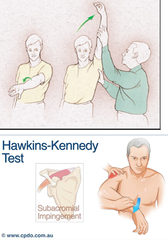
What are Key physical exam maneuvers for diagnosing Shoulder Pain With Impingement

answer
Neer's, Hawkins-Kennedy, cross-arm adduction
question
When a pt has Shoulder Pain With Impingement what should you do when evaluating the pt
answer
Evaluate for biomechanical factors: postural assessment (anterior head carriage, kyphosis, scoliosis), ROM (pec minor tightness, GIRD), flexibility, RTC strength (full vs. partial tear), & scapular mechanics (scapular dyskinesia) DON'T Forget to rule out injuries to surrounding areas: neck & upper limb, c-spine ROM, neurological exam MRI/US should be considered if significant RTC tears are suspected
question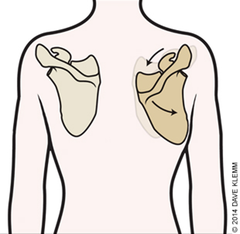
****What is the S.I.C.K Scapula Syndrome*

answer
S: Scapular malposition on the rib cage I: Inferior medial border winging from weak middle and lower trapezius muscles C: Coracoid pain and malposition from the attachment of a tight Pectoralis minor muscle pulling on the coracoid K: Scapular dysKinesis from alterations in muscle recruitment patterns The S.I.C.K. scapula is a pneumonic that was developed to help describe a group of findings in the shoulder and scapula
question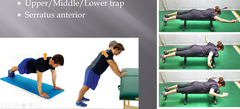
What is the goal of Shoulder Impingement Rehab

answer
Scapular rehabilitation: strengthening lower trap, middle trap, serratus anterior Normalize resting position - Correct imbalance of scapular stabilizers - Upper/Middle/Lower trap - Serratus anterior
question
Describe the approach for Shoulder Impingement Rehab
answer
1) Manual Therapy - Stretching the posterior shoulder capsule --> Spencer Technique - Stretching/relaxing the tight muscles that pull the scapula into a different position --> MFR and ST to pec minor and surrounding fascia --> MFR and ART to latissimus and teres in axilla 2) Therapeutic Exercise 3) Remember the order: - ROM/ flexibility - RTC strengthening - scapular strengthening & stabilization 4) Kinetic chain movements, plyometrics, sport specific exercises (athletes) 5) Home Exercise Program 6) Postural training 7) Take home stretches, exercises 8) Activity modification to minimize pain during functional task: - Lift objects close to the body - Only lift light weights &limit lifting to below shoulder level - Do sidestroke or breaststroke when swimming - Throw balls underhand or sidearm - Avoid pushing exercises at the gym --> (eg, pushups, bench press, flys, shoulder press) - Maintain good posture with writing, assembly work, and other tasks by keeping the shoulder blades down and back
question
Describe Therapeutic Exercise for Shoulder Impingement Rehab
answer
Therapeutic Exercise - ROM & Flexibility (Stage II) - Pendulum exercises: if pain free ROM needed - 2 areas responsible for impingement if tight: pec minor and posterior/inferior capsule --> Pec minor stretch --> Cross body adduction
question
Describe Strengthening of the rotator cuff with shoulder Impingement Rehab
answer
Strengthening of the RTC - Advance based on pain tolerance - Isometric with ext/int rotation - Isotonic strengthening with bands, resistance tubing or dumbbells
question
PT Prescription: Shoulder Pain
answer
PT 2-3x/week for 8-12 weeks Dx: R shoulder pain with AC arthritis, impingement symptoms & scapular dyskinesis Precautions: WBAT/Full pain-free ROM Treatment: - Modalities prn (cryotherapy, moist heat) - Manual therapy: ST mobilization, GH mobilization - Therapeutic Exercise: pain-free ROM, stretching (pec minor), strengthening (scapular stabilizers, RTC) - Specialized treatments: postural training - Please Provide HEP (Patient education)



